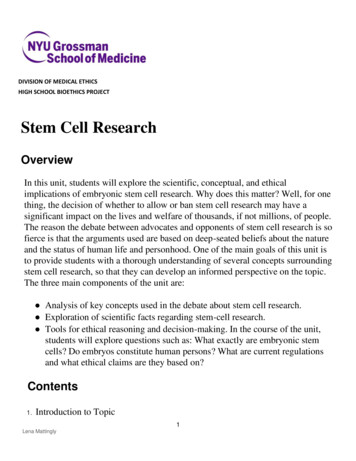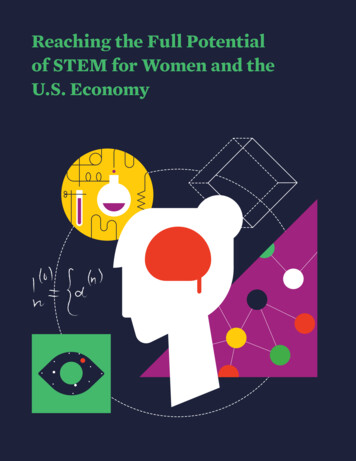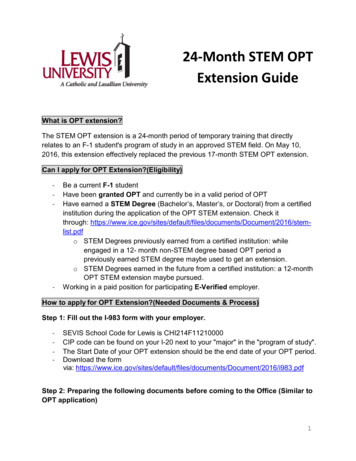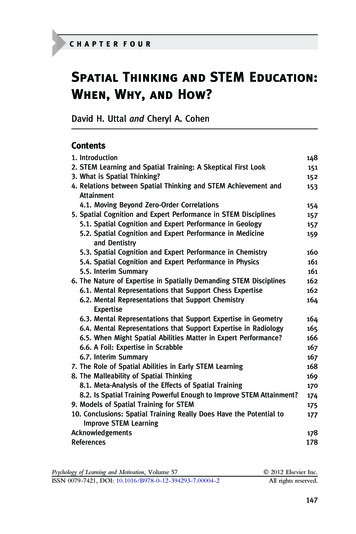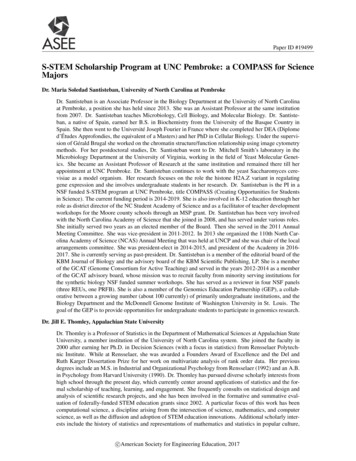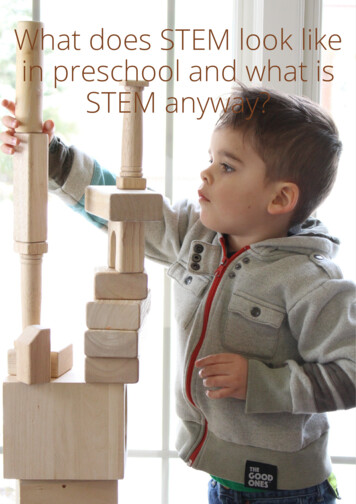
Transcription
Sarı, U., Duygu, E., Şen, Ö. F., & Kırındı, T. (2020). The Effect of STEM education.Journal ofTURKISH SCIENCE EDUCATIONVolume 17, Issue 3, September 2020TÜRK FEN EĞİTİMİ DERGİSİYıl 17, Sayı 3, Eylül 2020http://www.tused.orgThe Effects of STEM Education on Scientific Process Skills andSTEM Awareness in Simulation Based Inquiry LearningEnvironmentUğur SARI1, Esra DUYGU2, Ömer Faruk ŞEN3, Talip KIRINDI4 Prof. Dr., Kırıkkale University, Kırıkkale-TURKEY, ORCID ID: 0000-0002-3469-8959Graduate School of Natural and Applied Sciences, Kırıkkale University, Kırıkkale-TURKEY3Res. Asst., Kırıkkale University, Kırıkkale-TURKEY, ORCID ID: 0000-0002-2103-87914Prof. Dr., Kırıkkale University, Kırıkkale-TURKEY, ORCID ID: 0000-0001-8574-1673*This study is a part of the master thesis entitled “The effect of STEM education on science process skills andSTEM awareness in simulation based inquiry learning environment”.12Received: 26.06. 2019Revised: 30.04.2020Accepted: 06.05.2020The original language of article is English (v.17, n.3, September 2020, pp.387-405, doi: 10.36681/tused.2020.34)Reference: Sarı, U., Duygu, E., Şen, Ö. F., & Kırındı, T. (2020). The Effect of STEM Education on ScientificProcess Skills and STEM Awareness in Simulation Based Inquiry Learning Environment. Journal of TurkishScience Education, 17(3), 387-405.ABSTRACTIn this study, the effects of STEM education in the simulation–based inquiry learning (SBIL)environment on the students' scientific process skills and STEM awareness were investigated. In addition,the use of simulations in STEM education was discussed by evaluating students' views on activities.Study group of the research consists of 39 students enrolled in science teaching undergraduate program ata university in Turkey. Results of the study showed that STEM education performed in the SBILenvironment has a positive effect on the development of scientific process skills and STEM awareness.The students expressed a positive opinion on the STEM education that it provided the development ofscientific process skills and increased their attitude and motivation towards the course. The studentsstated that the simulation program used in the STEM activities provided important advantages such asdesigning and developing engineering products, experiments and reducing errors.Keywords: STEM; inquiry learning; computer simulation; scientific process skills; awareness.INTRODUCTIONOver the last decade, STEM education has been increasingly popular and it isconsidered one of the most important emphases in contemporary science education reformmovements (Wu & Anderson, 2015; Gül & Taşar, 2020). STEM (science, technology,engineering and mathematics) education involves integration of several disciplines, primarilyfour disciplines. It is argued that STEM education is vital for students to develop 21st centuryskills such as problem solving, innovation, creativity, communication and collaboration Correspondence author e-mail: usari05@yahoo.com ISSN:1304-6020387
388Journal of Turkish Science Education. 17(3),387-405(Bybee, 2010; Cooper & Heaverlo, 2013; Çepni, 2018). For this reason, STEM education hasbecome crucial in bringing the students to a level that can compete at the global level in the21st century (Breiner et al., 2012). In STEM education, students seek solutions to real lifeproblems. The problems encountered in real life have an interdisciplinary nature and cannotbe limited to the knowledge and skills of a particular discipline. Therefore, in order to solvethese problems, students must use the interdisciplinary approach of knowledge and skills ofdifferent disciplines by its nature (Wang, 2012; Wang et al., 2011). Many researchersemphasize the need for an integrated education in which interdisciplinary boundaries areremoved for an effective STEM education (Breiner et al., 2012; Morrison & Bartlett, 2009).On the basis of STEM education; there is an inquiry approach that drives students toresearch, produce and make new discoveries. Therefore, STEM learning environments shouldbe arranged in this direction and so it can provide opportunities for students to develop 21stcentury skills such as problem solving, critical thinking and creativity. In this context, STEMeducation is a process in which students collaborate with scientific inquiry and engineeringdesign in collaborative environments to solve real life problems (Suratno, et al., 2020). In thisprocess, teachers guide the students to question the main problem they have faced and providethe opportunity for students to find solutions to the problem on their own. At this point,inquiry-based learning constitutes the pedagogy of STEM education (Crippen &Archambault, 2012). For this reason, teachers have a key role in integrating STEM intocourses.In the 21st century, when knowledge and technology grew exponentially, educators andresearchers increasingly stressed the potential power of educational technology to improveSTEM learning outcomes (Wu & Anderson, 2015). Therefore, the use of educationaltechnologies such as augmented reality, simulations and robotic applications has become animportant issue for researchers in STEM education (Wu & Anderson, 2015). Researches showthat simulations can provide STEM literacy development (Rutten, van Joolingen, & van derVeen, et al., 2012) and STEM awareness in students (Gül & Taşar, 2020). D’Angelo et al.(2013) argued that the positive effects of the simulations are evident in studies, but there isstill a lot to learn about the educational benefits of computer simulations in STEM areas. Oneof the important research topics in STEM studies is simulation-based inquiry learning. Also,scientific process skills are central to STEM education.In this study, undergraduate students of science education were encouraged to solve theengineering problems in a simulation-based inquiry learning environment. The aim of thisstudy is to investigate the effects of STEM education on STEM awareness and scientificprocess skills and to evaluate students' opinions about using STEM applications andsimulations. For this purpose, research problems have been created as:1. Is there a statistically significant difference between STEM awareness levels ofstudents before and after the practice?2. Is there a statistically significant difference between the scientific process skills of thestudents before and after the practice?3. What do students think about the use of simulation in inquiry-based STEM education?4. What are the students' views on the use of the simulation program in STEMapplications?Theoretical FrameworkInquiry based learning (IBL) strategy in STEM educationAccording to Sanders (2009), STEM education should focus on the application ofmathematics, science and engineering knowledge, designing and executing experiments,analyzing and interpreting data, and corporate communication with teams from different
Sarı, U., Duygu, E., Şen, Ö. F., & Kırındı, T. (2020). The Effect of STEM education.disciplines. An effective STEM education should not only focus on the content of science, butalso encourage understanding and evaluation of curiosity, evidence-based reasoning, andscientific inquiry processes (). In addition, in the analysis of STEM programs and curriculumdesign; by developing a solution, problem solving and inquiry emerge as two major focusesof STEM integration (Morrison & Bartlett, 2009). Therefore, teaching STEM integrationshould not only focus on content knowledge, but also problem-solving skills and inquirybased learning. STEM learning environments promote creativity through the use of inquiryapproach, offer opportunities for teamwork, and emphasize inquiry rather than memorizationinformation (Wang et al., 2011). In inquiry-based learning, students produce their ownscientific questions, develop critical questions, search for possible solutions, prioritizeevidence in answers to questions, generate explanations from evidence, link to scientificinformation, communicate, and share findings (Imaduddin & Hidayah, 2019; Rushton, Lotter& Singer, 2011).Inquiry-based learning focuses on original problems and issues related to students andthe daily life. In addition to the aspects to be learned, students play an important role indetermining the questions to be examined. In this approach, where deep understanding isintended, learning is done through the study, design, modeling, interviews, research and otheractive discovery types that lead students to new understanding. Teachers facilitate thelearning process by guiding students and structuring the learning environment (Li, Moorman& Dyjur, 2010). The inquiry-based learning is characterized by questioning, practical activityand critical thinking in science classes (Gerber et al., 2003). Students are encouraged toquestion, to do research, to learn, to report their effects and to evaluate their knowledge (VanZee & Roberts, 2006). Among the benefits of using the inquiry approach are furtherpreservation of factual information, greater flexibility and creativity in problem solving, andensuring student motivation (Lord & Orkwiszewski, 2006). The integration of STEMeducation can be achieved through the operation of the engineering design cycle in theinquiry-based learning process. In this study, a five-stage inquiry-based learning cycleproposed by Lim (2004) was used. These stages and brief definitions are given below:1. Ask: The students brainstorm about the scope of the problem and the issues thatinvolve solutions.2. Plan: Students plan the solution process of the problem.3. Explore: Students do research to solve the problem and collect data for solution.4. Construct: Students analyze research data and provide solutions.5. Reflect: Students discuss problem solutions and results.Computer simulations in Inquiry-Based Learning StrategyComputer simulations such as animations and virtual labs provide theoretical orsimplified models of real-life processes and phenomena (Smetana & Bell, 2012). Simulationscan help in the implementation of educational reforms by facilitating inquiry-based learningand provide STEM literacy development in students (Rutten, van Joolingen & van der Veen,2012). They also play a critical role in helping students visualize scientific facts (Srisawasdi,Kerdcharoen, & Suits, 2008). They enable the complex and invisible nature of the concepts tobe visual (Rutten et al., 2012). Moreover, students observe, discover, rebuild, and receiveimmediate feedback about real objects, events and processes with simulations presentingdynamic theoretical or simplified models of phenomena. Students can also do a virtualexperiment with changing variables and recording scientific results with interactivesimulations. They encourage active participation in higher-order thinking and problemsolving and facilitate learning of abstract concepts (Mcdonald, 2016). Simulations for inquirybased teaching are a promising field in terms of strengthening students' mental interaction389
390Journal of Turkish Science Education. 17(3),387-405with the physical and social world to develop a scientific understanding, explanation, andcommunication between science ideas (Srisawasdi & Panjaburee, 2015). If students want tohave an active role in their own learning process, the simulations can be used to supportauthentic inquiry activities, including creating questions, developing hypotheses, andcollecting data (Rutten, Joolingen & Van der Veen, 2012). In a simulation-based inquiry,students come across two processes as transformational and regulatory (Njoo & De Jong,1993). In transformational process, students produce direct information with forming ahypothesis, designing experiments, drawing a conclusion. In orientation process, studentsassociate the variables, conditions and events presented in the problem, identify importantvariables and visualize the simulation conditions. Regulatory process means planning andmonitoring the learning process (Linn et al., 2004). As a result, the simulations can play anactive role in STEM teaching, in terms of both supporting the inquiry processes and providinga modeling opportunity.METHODSMixed method research was preferred because quantitative and qualitative methodswere used together. The mixed method is defined as the combining of qualitative andquantitative methods, approaches and concepts in a study (Johnson, & Onwuegbuzie, 2004).The purpose of the mixed method is to expand the understanding of the event (Leech &Onwuegbuzie, 2009). In the quantitative dimension of the study, single group pre-test posttest experimental design was used. In this model, an experimental group was formed on avoluntary basis. The Scientific Process Skill Test and STEM Awareness Scale were applied aspre-test and post-test in order to examine the changes in students' scientific process skills andSTEM awareness. In the qualitative dimension of the study, the students’ views on STEMactivities were collected via a semi-structured interview form. In order to support the findingsobtained in the quantitative dimension of the research, students' opinions were examined atthe end of the research.a) The Study GroupIn order to determine the study group, convenience-sampling method was used frompurposeful sampling methods. Easy-to-use status sampling, which is widely used inqualitative research, provides an advantage in terms of cost and time (Yıldırım & Şimşek,2011). For this purpose, considering the laboratory facilities, technological infrastructure andsuitable class size for STEM activities, the research was carried out with 39 undergraduatestudents (34 girls and 5 boys) who are enrolled in General Physics Laboratory III course inthe second year of Science Education Program in a university in Central Anatolia, Turkey.b) Development and Implementation of STEM ActivitiesIn the study, five simulation-based inquiry-learning activities were conducted within thescope of the Physics Laboratory III course. The application was carried out over 2-hourcourse per week for 10 weeks. Each activity lasted for 2 weeks (4 lessons) in the areas ofdiffusion of light, reflection in the mirrors, refraction of light, lenses, mirrors and the use oflenses. The learning objectives and the briefs of STEM with IBL activities are given in Table1. Each activity starts with a scenario containing a real-life engineering problem. Studentscompleted the 5-stage inquiry cycle (Lim, 2004) and 4-stage engineering design processes(Wendell et al., 2010) to solve the engineering problem given in the scenario simultaneously.
Sarı, U., Duygu, E., Şen, Ö. F., & Kırındı, T. (2020). The Effect of STEM education.Table 1. Learning objectives and the brief STEM with IBL activities of each lessonSTEM Activities1- Spreading ofLight“Melek's VillageAdventure “2- MirrorReflection"Technology inWars"Learning Objectives- Knows that engineering design process consists of stepsthat can be used to solve problems.- Knows that a light from a source follows a linear pathin every direction and shows with drawing.- Explains the relationship between the reflected beam,the normal of the surface and the incoming beam withoutreflection.- Realizes the negative effects of light pollution andexplains.- Knows that optical engineers use science andmathematics knowledge to solve their problems.- Compares the images formed in straight, pit and bumpmirrors.- Explains the relationship between the reflected beam,the normal of the surface and the incoming beam withoutreflection- Knows image formation and image properties.ScienceLight source, lightrays, reflection inlight, lightdiffusion, lightpollutionReflection of lightin mirrors,reflection laws,image formationand properties,special situationsand concepts inmirrorsTechnologyEngineeringMathematicsSelection of materialsto be used in theillumination tool,usability and cost.The use of simulationsin model designPreparation of differentdesigns for light pollutionsolution, decisionmaking, preparation andapplication of the mostappropriate selection.Determination of distanc mpare the STEM awareness of thestudents before and after the activity. T-test results of STEM awareness pre-test post-testscores are given in Table 3. There is a statistically significant difference between the students'STEM awareness pre and post-test scores. The pre-test average of students was X 2.82,while the post-test average was X 3.54. Cohen d value was found to be 3.92. Consequently,it can be seen that the activities used during the applications have a significant positive effecton STEM awareness and have a wide impact value.393
394Journal of Turkish Science Education. 17(3),387-405Table 3. Comparison of paired samples t-test results of STEM t-Test393,540,23pd,002,49Secondly, a paired samples t-test with pre and post test score of students SPST wasapplied to observe how the SBIL activities affect the students' SPS. The paired samples t-testresults for the scientific process skills test are given in Table 4. There is a statisticallysignificant difference between the pre-test and post-test scientific process skills test scores ofthe students. STEM education has a positive effect on students' scientific process skills. Theeffect size index was found to be 0.70 as medium effect size.Table 4. Comparison of paired samples t-test results of t3924.185.18pd.000.70b) Students' views on SBIL activities that integrate STEMThe students' opinions about SBIL activities including STEM disciplines were gatheredunder three main themes (Table 5). The students determine that STEM education is effectivein the fields of knowledge, skills and affective learning. The positive opinions expressed bythe students are categorized as sub-themes under the main theme of “STEM's effect onlearning” and the codes are given in Table 6.Table 5. Theme and sub-themes of student views about SBIL activities integrated with STEMdisciplinesThemeSub-themesSkill developmentStructuring and supporting informationThe effect of STEM on learningAttitude and motivation orientationInnovationChallenges related to knowledge and skillsChallenges in STEM educationNegative attitudeLimitationsAdvantagesUse of simulation in STEM educationDisadvantagesWhen the answers to the question “In your opinion, What skills can be developed whenSTEM education is received? were examined; many students stated that their 21st centuryskills such as problem solving, creativity skills, analytical thinking, teamwork andcooperation have been improved. In addition, it was found that basic skills such as thinkingskills, dexterity, ability to form hypothesis, and scientific process skills could develop (Table6). Some student opinions on the subject are; “Thinking and imagination skills developbecause it is thinking how to do before doing something which is important in designs.” (F1),“It gives creative thinking skills because it teaches thinking more broadly.” (M4), “Itcontributes to group work and finding multiple solutions to problems.” (F9).When the answers to “What contributions can STEM education make to scienceeducation as there is interdisciplinary interaction?” were examined; the contributions toscience education are gathered under the sub-theme of “structuring and supportingknowledge” (Table 6). The views of the students in this area were that the knowledge was
Sarı, U., Duygu, E., Şen, Ö. F., & Kırındı, T. (2020). The Effect of STEM education.realized and effective learning with grip and fun took place through the activities of SBIL.The opinions of some students on the subject are “It is absolutely necessary for our educationsystem because students learn to design what they think.” (M3), “Collaborative work appearswithin the group. Students create self-confidence. It provides more permanent information.”(F19).“Do you think it would be useful to perform STEM activities in your undergraduatestudy as a teacher candidate?” When the answers to this question were examined, it was seenthat the most participation was gathered under the attitude and motivation orientation towardsthe course (Table 6).Table 6. Sub themes, codes and frequencies related with STEM's effect on learningMainSub-ThemeCodesFrequency (f)ThemeProblem solving skills25Thinking skill22Development of dexterity21Creativity skills19Team work9Setting up a ytical thinking skills5Communication skills3Critical thinking skills2Mathematical Thinking1Making a decision1Specifying variables1Psycho-motor skills1Effect ofEnsuring concretize21STEM onEffective learning15LearningConfiguring andTo be student-centered9SupportingEnsuring comprehension6InformationLearning by fun6Completing the topic3Using your imagination9Increasing interest in the course9Attitude andProfessional development8MotivationProviding student n of events2Find the solution to the problem16Interdisciplinary interaction7InnovationsEngineering product creation6Determining the problem sentence3The most important point of the student responses about STEM's effect on learning is touse the imagination, to increase the interest in the lesson and to provide professionaldevelopment. When the opinions of the students about the question are examined, 92.3%stated that the participation of STEM activities during the undergraduate education wouldcontribute positively to their development. The other students in the remaining percentage didnot express their opinions. Students on this subject stated that “Students have positive features395
396Journal of Turkish Science Education. 17(3),387-405on to solve problems in everyday life more concretely, to develop imagination, and toincrease handicraft” (F26), “I think
voluntary basis. The Scientific Process Skill Test and STEM Awareness Scale were applied as pre-test and post-test in order to examine the changes in students' scientific process skills and STEM awareness. In the qualitative dimension of the study, the students' views on STEM activities were collected via a semi-structured interview form.


